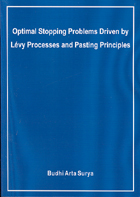
Optimal Stopping Problems Driven by Lévy Processes and Pasting Principles / Budhi Arta Surya - [S.l.] : [s.n.], 2007 - Doctoral thesis Utrecht University

 |
Optimal Stopping Problems Driven by Lévy Processes and Pasting Principles Optimal Stopping Problems Driven by Lévy Processes and Pasting Principles / Budhi Arta Surya - [S.l.] : [s.n.], 2007 - Doctoral thesis Utrecht University |
Solving optimal stopping problems driven by Lévy processes has been a challenging task and has found many applications in modern theory of mathematical finance. For example situations in which optimal stopping typically arise include the problem of finding the arbitrage-free price of the American put (call) option and determining an optimal bankruptcy level in the problem of endogenous bankruptcy. The main concern in pricing the American put (call) option lies in finding the critical value of the stock price process below (above) which the option is exercised. In the case of endogenous bankruptcy, the problem mainly deals with finding an optimal bankruptcy level of a firm which keeps a constant profile of debt and chooses its bankruptcy level endogenously, to maximize the equity value. In the context of the theory of optimal stopping, the arbitrage-free price of the American put (call) option and the equity value of the defaultable firm correspond to the value function of an optimal stopping problem while the critical value of the stock price process and the bankruptcy level correspond to the optimal stopping boundary. In general, optimal stopping problems are two-dimensional in the sense that they consist of finding the value function and the stopping boundary simultaneously; that is to say that the value function can be seen as a function of an unknown stopping boundary. Thus, from an analytical point of view, solving the problem is difficult. A major technique that has been widely used in the theory of optimal stopping problems driven by diffusion processes is the free boundary formulation for the value function and the boundary. The free boundary formulation consists primarily of a partial differential equation and (among other boundary conditions) the continuous and smooth pasting conditions used to determine the unknown boundary and specify the value function. The first condition requires the value function to be continuous at the boundary while the second condition imposes a C1 smoothness of the value function at the boundary. Depending on the nature of the problem and the sample paths of the Lévy process, the smooth pasting condition may break down. As will be shown in this thesis, this phenomenon can happen to be the case when the Lévy process has paths of bounded variation. As a result, for this type of Lévy process, the continuous pasting condition appears to be the only criterion for choosing the boundary. Thus, a better understanding of the appropriate choice of pasting conditions can play an important role in the theory. Much of this thesis is concerned with solving optimal stopping problems driven by Lévy processes in a general setting. The aim is to expose a framework by which explicit solutions can be obtained. Using such solutions, we give sufficient and necessary conditions for the continuous and smooth pasting conditions to occur in the considered problem. In this thesis we give examples of different cases. Most of the main results presented in this thesis are illustrated by means of numerical examples for Lévy processes having one-sided jumps. keywords: Lévy processes, Wiener-Hopf factorization, optimal stopping problems, pasting principles, the American put (call) option problems, credit risks, numerical Laplace inversions |